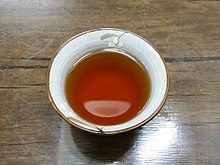낫팟티
Sicklepod tea | |
| 유형 | 차 |
|---|---|
| 원산지 | 한국 |
| 재료 | 낫팟씨 |
| 한국이름 | |
| 한글 | 결명자차 |
|---|---|
| 한자 | 決明子茶 |
| 수정 로마자 표기법 | 결명자차 |
| 매쿠네-라이샤워 | 경명자차 |
| IPA | [kjʌl.mjʌŋ.dʑa.tɕʰa] |
결명자차(결明子車, 決明子子, sickle明子茶, sicklepod子茶) 또는 낫팟차는 세나(구 카시아) spp의 볶은(단, 빻지 않은) 씨앗으로 만든 차인데, 특히 S. obtusifolia와 S. tora.
성분
결명자(결明子; 決明子)[2][3][4]의 볶은 씨앗이 사용되는데,[1] 이것은 카시아씨앗 중국어:juémng zǐ, 일본어: ketsumeisi),[2] 즉, 레귤러 식물의 카시아(Senna)씨씨씨, 특히 S. obtusifolia와 S. tora.
그러나 한 소식통은 이 성분을 차메크리스타 노마메와 동의어인 [5]카시아 노마메와 관련된 식물로 파악하고 있다.[6]
준비
약 20-30g(0.71–1.06온스)의 마른 낫팟 씨앗을 볶아 약 600밀리리터(21 imf floz; 20 US floz)의 물에 데쳐낸다.[7]설탕이나 꿀은 첨가되지 않는다.[7]
사용하다
결명자란 '눈을 밝게 하는 씨앗'[8]이라는 뜻이다.결명자차는 한약재로도 쓰인다.
유사음료
일본에서 하부차는 원래 하부소나 S.오시덴탈리스에서 양조한 구운 카시아 씨앗을 주입한 것을 말했으나, 현재 상업적으로 판매되고 있는 하부차는 대개 S. 둔부시폴리아로 만들어진다.[9][10]
앞서 언급한 차메크리스타 노메는 일본에서 카와라케츠메이(カ原ki, 문자 그대로 '리버뱅크 식레팟')라고 불리며, 잎과 씨앗은 마메차(馬amecha) 또는 하마차(하마차)라고 불리는 뜨거운 음료로 만들어지는데, 특히 규슈와 같은 남부 지역에서 더욱 그러하다.[11][12]
카시아씨앗차는 동아시아(중국일본한국)뿐만 아니라 동남아시아(태국 등)에서도 소비되고 있다.[13]태국에서 S.오라는 촉헤트타이(ช heเห็ดดดยยยยย)라고 불리는데,[13][14] 볶은 씨앗은 이뇨제로, 씨앗이나 잎은 정제로 쓰인다.[13][15]
볶아서 갈아 먹는 카시아 토라 씨앗은 인도에서 에르사츠 커피로 주목받았고, C.오시덴탈리도 아프리카, 남미, 서인도 제도에서 '네그로 커피'로 불렸던 것으로 양조되었다.[16][13]이 잎들은 비록 좋지 않지만 인도에서 대체 커피로 사용되었다.[13]
참고 항목
참조
- ^ "gyeolmyeongja-cha" 결명자차. Standard Korean Language Dictionary (in Korean). National Institute of Korean Language. Archived from the original on 2018-07-09. Retrieved 28 January 2017.
- ^ a b Wang, Yuan; Sheir, Warren; Ono, Mika (2010). Ancient Wisdom, Modern Kitchen: Recipes from the East for Health, Healing, and Long Life. Hachette Books. p. 23. ISBN 9780738214054.
- ^ International Food Information Service (2009). IFIS Dictionary of Food Science and Technology (2 ed.). John Wiley & Sons. p. 79. ISBN 9781405187404.
- ^ Chinese Medicine Quality Standardization Research Project Team, National Institute of Food and Drug Safety Evaluation (2018-07-12), Gyeolmyeongja 결명자 (決明子) [Cassiae Semen]
- ^ The Korea Foundation (2014). Korean Food Guide. The Korea Foundation. ISBN 9791156040804.
- ^ Bisby, Frank (1994). Phytochemical Dictionary of the Leguminosae. CRC Press. p. 765. ISBN 9780412397707.
- ^ a b 김, 상현. "gyeolmyeongja-cha" 결명자차. Encyclopedia of Korean Culture (in Korean). Academy of Korean Studies. Retrieved 9 May 2017.
- ^ Lee, Yeongsu (March 17, 2012). "Food that protects people from yellow dust(황사에 도움이 되는 음식)". Retrieved 22 March 2018.
- ^ Okada, Minoru (2002). Shintei genshoku makino wakan yakusō daizukan 新訂原色牧野和漢薬草大圖鑑 [New edition of Makino's great encyclopedia of Japanese and Chinese medicinal herbs in original color] (in Japanese). Hokuryukan. pp. 204, 205. ISBN 9784832608108.
- ^ Tōhō University, Yakugakubu fuzoku yakuyō shokubutsuen (medicinal herbarium attached to pharmacology dept.) (May 2019). "Ebsisugusa" エビスグサ. Yakuyō shokubutsuen mihon-en 薬用植物園 見本園 (in Japanese). Retrieved 2020-12-19.
- ^ Ochiai, Yukino (2013-12-24). "Chagai no cha: shikōhin to iyakuhin no hazama de" 茶外の茶 : 嗜好品と医薬品のはざまで [History and current status of herbal tea for both refreshment and health benefits]. The memoirs of the Institute for Oriental Culture. 164 (164): 89–87. doi:10.15083/00026847. (일본어로, 영어 추상적으로)
- ^ Katanoda, Itsurō (1999). Ryūkyū ko/noyama no hana From Amai: taiyō no okurimono 琉球弧・野山の花 From Amami: 太陽の贈り物 [Ryukyu Arc/flowers of the fields and mountains; From Amami: gift of the sun] (in Japanese). Nanposhinsha. p. 59. ISBN 9784931376212.
- ^ a b c d e Kijima, Masao (1969). "Tai koku shōyaku no kōsatsu III" <報告>タイ国生薬の考察 III [Observations III on herbal medicine in Thailand]. Japanese Journal of Southeast Asian Studies (in Japanese). 7 (1): 78–79. hdl:2433/55564.
- ^ Mulholland, Jean (1989). Herbal Medicine in Paediatrics: Translation of a Thai Book of Genesis. Faculty of Asian Studies, Australian National University. p. 324. ISBN 9780731507917.
- ^ Mulholland, Jean (1989). Medicine, Magic and Evil Spirits: Study of a Text on Thai Traditional Paediatrics. Australian National University. p. 287. ISBN 9780731500161.
- ^ Watt, George (1889). A Dictionary of the Economic Products of India: Cabbage to Cyperus. Superintendent of Government Printing. p. 226.


